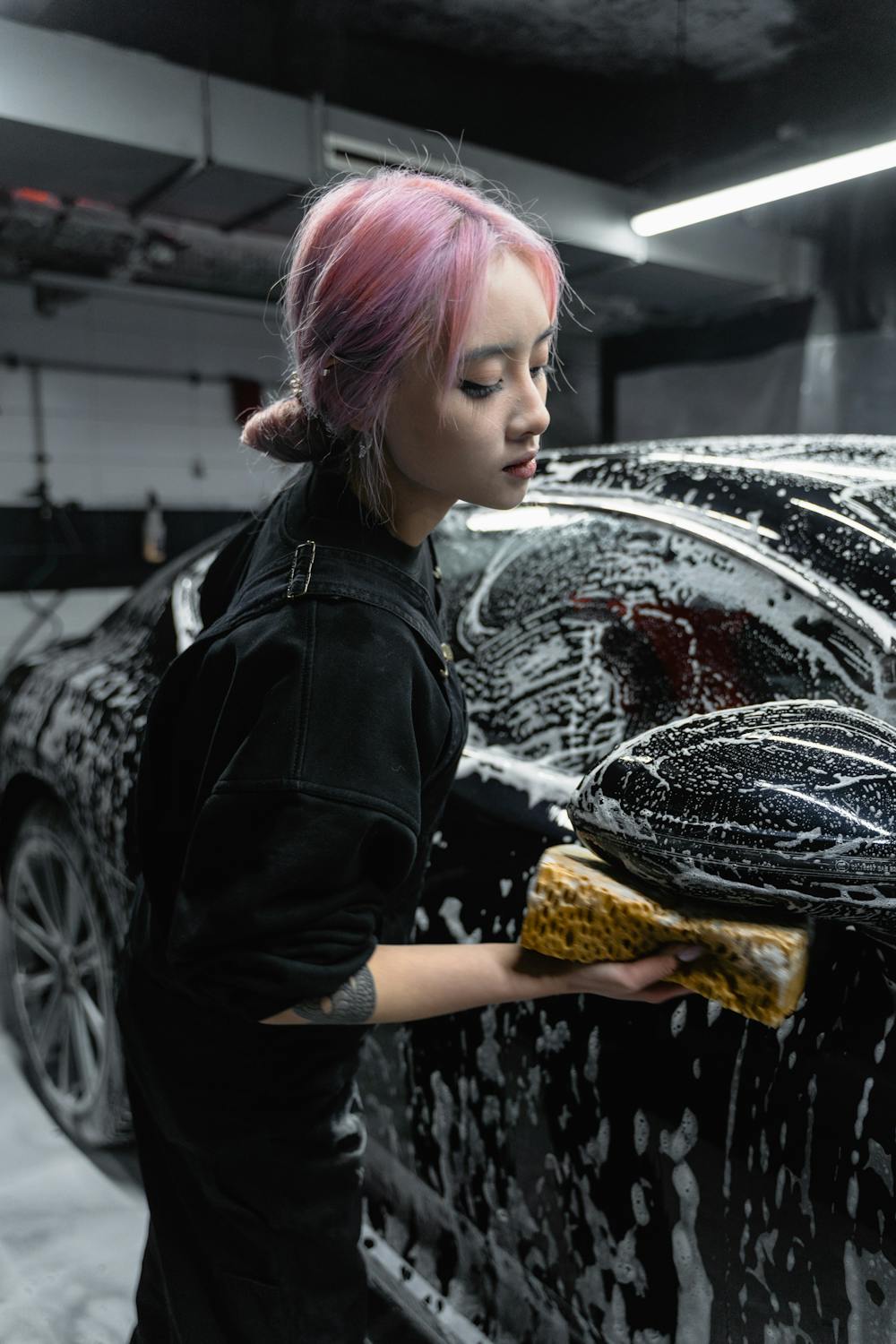How Weather Affects Ceramic Coating Performance

How Weather Affects Ceramic Coating Performance

Introduction
Ceramic coatings provide excellent protection for your vehicle's paint, but their performance isn't identical in all weather conditions. Understanding how different environmental factors affect your coating can help you maintain its appearance and protective properties year-round. This comprehensive guide explores the relationship between weather conditions and ceramic coating performance.
Extreme Heat and Sun Exposure
Effects on Ceramic Coating
High temperatures and intense UV radiation can impact ceramic coatings in several ways:
- Accelerated Curing: Excessive heat during installation can cause the coating to flash cure before proper leveling
- UV Resistance: Quality ceramic coatings contain UV inhibitors that prevent paint oxidation and fading
- Surface Temperature: Dark-colored vehicles can reach surface temperatures of 180°F+ in direct sunlight
Performance Benefits
- Most ceramic coatings are heat-resistant up to 1200°F (far beyond what your vehicle will experience)
- The SiO2 (silicon dioxide) in ceramic coatings is naturally resistant to UV degradation
- The slick surface prevents contaminants from bonding to paint in hot conditions
Challenges in Hot Weather
- Water spotting can be more pronounced as mineral-laden water evaporates quickly
- Dust and pollen adherence may increase during dry, hot conditions
- Improper application in hot weather can lead to high spots and streaking
Maintenance Tips for Hot Climates
- Wash early morning or evening to prevent rapid water evaporation
- Use a ceramic boost spray quarterly to maintain hydrophobic properties
- Park in shaded areas or garages when possible
- Address water spots promptly before they etch into the coating
Cold Weather and Freezing Conditions
Effects on Ceramic Coating
Cold weather presents different challenges for ceramic coated vehicles:
- Reduced Hydrophobicity: Extremely cold conditions can temporarily reduce water beading
- Snow and Ice Adhesion: While coatings reduce snow and ice buildup, they don't eliminate it
- Salt and Road Chemicals: Winter road treatments can be highly alkaline and potentially damaging
Performance Benefits
- Ceramic coatings create a barrier against road salt and deicing chemicals
- The slick surface helps prevent snow and ice from bonding as strongly
- Coated vehicles are easier to clean after winter driving
Challenges in Cold Weather
- Washing becomes difficult in below-freezing temperatures
- Road grime and salt accumulation is more aggressive
- Automatic car washes with brushes can damage the coating
Maintenance Tips for Cold Climates
- Perform a thorough decontamination wash before winter season begins
- Apply a ceramic boost spray before the onset of winter
- Rinse vehicle frequently to remove salt accumulation
- Use touchless wash facilities when temperatures prevent hand washing
- Apply a ceramic-safe snow foam pre-wash when washing in winter
Rain and High Humidity
Effects on Ceramic Coating
Rainy conditions showcase one of the most visible benefits of ceramic coatings—hydrophobicity:
- Water Beading and Sheeting: Quality coatings create tight beads that roll off easily
- Self-Cleaning Effect: Rain helps clean light dust and pollen from coated surfaces
- Spot Prevention: Proper sheeting reduces water spot formation
Performance Benefits
- Improved visibility while driving in rain as water sheets off quickly
- Reduced need for wiper use on rear windows and side mirrors
- Faster drying time after rain stops
Challenges in Rainy Conditions
- Acid rain can leave spots if allowed to dry on the surface
- High humidity can affect initial coating application and curing
- Standing water for extended periods may cause temporary water spotting
Maintenance Tips for Rainy Climates
- Apply ceramic coating products with higher SiO2 content for better water behavior
- Use a leaf blower or dedicated car dryer after rain to prevent spots
- Consider a ceramic-infused drying aid for quick maintenance
- Don't allow the vehicle to air dry after rain when possible
Coastal Environments and Salt Air
Effects on Ceramic Coating
Salt air presents unique challenges for any paint protection system:
- Salt Crystallization: Airborne salt can deposit on surfaces and crystallize
- Accelerated Degradation: Salt is corrosive and can accelerate coating breakdown
- High UV Exposure: Coastal areas often have intense sun exposure
Performance Benefits
- Ceramic coatings provide a sealed barrier against salt penetration
- Regular maintenance is easier on coated surfaces
- Corrosion resistance is significantly improved
Challenges in Coastal Areas
- Salt deposits can be abrasive if not removed properly
- Marine layer moisture can carry dissolved salt
- More frequent maintenance is required than in inland areas
Maintenance Tips for Coastal Living
- Rinse vehicle more frequently (ideally weekly)
- Apply ceramic boost sprays more often (every 2-3 months)
- Perform a clay bar treatment quarterly to remove bonded salt particles
- Consider a higher-grade professional coating with 98%+ SiO2 content
Seasonal Transitions and Their Impact
Spring Challenges
- Pollen accumulation can be significant
- Increased rainfall and humidity
- Tree sap becomes more common
Maintenance Focus: Regular rinsing to remove pollen, addressing tree sap immediately.
Summer Challenges
- Intense UV exposure
- Bug splatter and road tar
- Water spotting from irrigation sprinklers
Maintenance Focus: Frequent washing, bug remover products, avoiding midday washing.
Fall Challenges
- Tree sap and fallen leaves
- Early frost conditions
- Varying temperature swings
Maintenance Focus: Removing fallen debris promptly, preparing for winter conditions.
Winter Challenges
- Road salt and deicing chemicals
- Freezing temperatures limiting washing
- Abrasive road grit
Maintenance Focus: Frequent rinsing when temperatures allow, touchless washing methods.
The Science: Why Weather Affects Ceramic Coatings
At a molecular level, ceramic coatings create a rigid lattice structure on your paint. This structure is generally stable across temperature ranges, but extreme conditions can affect performance:
- Thermal Expansion: Minor expansion and contraction occur with temperature changes
- Chemical Interactions: Environmental contaminants can temporarily bond to the coating surface
- Surface Energy: The hydrophobic properties rely on maintaining low surface energy, which can be temporarily affected by environmental deposits
Long-Term Weather Exposure: What to Expect
Over the life of a ceramic coating (typically 2-5 years depending on grade), expect these weather-related changes:
- Gradual reduction in hydrophobic properties (rejuvenated with maintenance products)
- Slight diminishing of gloss in extreme UV environments without proper maintenance
- Potential for spot etching in areas with heavy industrial fallout or acid rain
Professional vs. Consumer-Grade Coatings in Extreme Weather
- Professional Coatings: Typically offer better chemical resistance and longevity in extreme conditions
- Consumer Products: May require more frequent maintenance to maintain properties in harsh environments
- Installation Quality: Professional application often includes better surface preparation, critical for longevity
Conclusion
Ceramic coatings provide excellent protection against various weather conditions, but they aren't completely immune to environmental factors. Understanding how different weather affects your coating will help you maintain its protective properties and appearance.
The key to maximizing ceramic coating performance in any climate is consistent maintenance tailored to your specific environmental challenges. With proper care, your ceramic coating can provide years of protection against whatever weather conditions you encounter.
About the Author

Lisa Thompson
Lisa is a content creator specializing in automotive care. She has collaborated with major ceramic coating brands and produces educational content for DIY enthusiasts.
Related Articles
Related Articles

Addressing Common Issues Post-Application
November 2, 2023

Removing Ceramic Coating: A How-To Guide
October 15, 2023

Can You Apply Ceramic Coating Over Existing Wax?
December 10, 2023